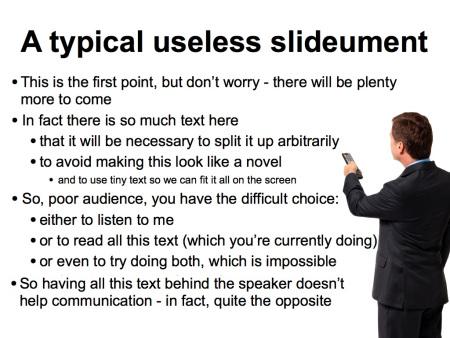There is a feeling that a presentation can’t be “scientific” unless it has bulletpoints, that transfer of information requires a list of facts on the board and that these should be worked through in order. There is no justification for this other than history. It has been this way since time began. Or actually it has only been this way since people have been using powerpoint.
The educational theory is clear that this is both a bad way of presenting and a very ineffectual method of transferring information. It is great in textbooks and actually a good way to take notes from a lecture but in a presentation it simply doesn’t work. Cognitive load describes the problem where the brain is presented with an image and speech at the same time. This isn’t difficult to deal with as it represents daily life; we look out at the world and speak, we can listen and watch at the same time. Although, to be fair when things are complex one action is usually prioritised. Reading and listening at the same time is a bigger cognitive challenge particularly if the reader gets ahead of the speaker as happens if there is a large amount of text presented.The focus then becomes the text and, whatever the efforts of the speaker, the audience become fixated on the text behind. What happens if one is trying to read something and people are constantly interrupting you? Such as children. Or the presenter.
Is it possible to present a long list of facts then without text? Of course it is. But that isn’t how we learn or transfer information. Do we need the structure of a talk presented in text? Of course we don’t, that’s not how plays or books or films or jokes work either. Do we need annotation of images? No. The reason people put bulletpoints and text behind them is a combination of tradition and sadly the construction of the presentation; the slideument. Recognising that the text of p2 detracts attention, constrains the speaker and limits expansion is the first step. Many people remember how good a lecture was when the lecturer couldn’t get the computer to work or someone used a flip chart or simply spoke from the heart with nothing behind them.
There is a feeling that without this the audience may have to work harder to understand what is going on. They do. And this aids understanding. If you find your way somewhere without a map you will get home again. How many of us are lost once we reach our destination and the sat nav dies? Recognising that sharing knowledge is more than reciting facts listed on a screen will liberate the teacher, empower the manager and develop the student making their presentations.
Bulletpoints are not scientific and don’t aid, they limit.
9SNSNB9W9CQF

Pingback: A scientific presentation at BBTS Conference - p cubed presentations